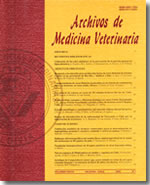Evaluation of a traditional program of training in chilean rodeo criollo horses through the analysis of physiological and blood biochemical changes
Main Article Content
Abstract
A study in order to determine the effects on cardiovascular, respiratory, endocrine and metabolic variables of a traditional training program for Chilean Criollo horses was carried out. In order to analyse the level of work under which the horses are trained, the race track and the time of exercise were measured to determine work speed. Heart rate, respiratory rate were measured. Blood samples were used to measure packed cell volume, haemoglobin, total proteins, glucose, triglycerides, lactic acid, insulin, cortisol, and electrolites (Na, Cl and Ca). The activity of enzymes, creatin kinase, lactic dehydrogenase and aspartate amino transferase were obtained before and after each training exercise. The physiological and blood biochemical variables were measured on days 0, 15, 30 and 45 of training.
According to the results obtained it is concluded that the traditional on farm training exercise for Chilean Criollo horses is a short term and low speed exercise which represent a physical work of moderate intensity, producing small changes on physiological and blood biochemical variables suggesting that the principal aim of the conditioning program is to improve the ability of horses to stop the steers in the rodeo track than to obtain better physical fitness.

